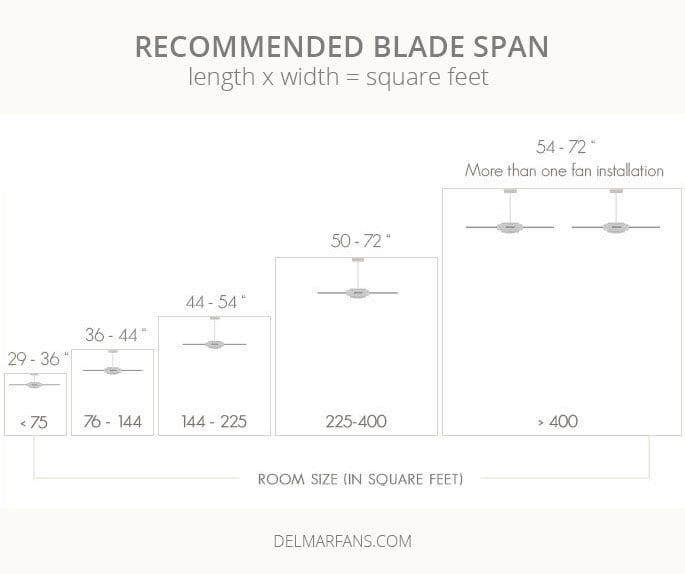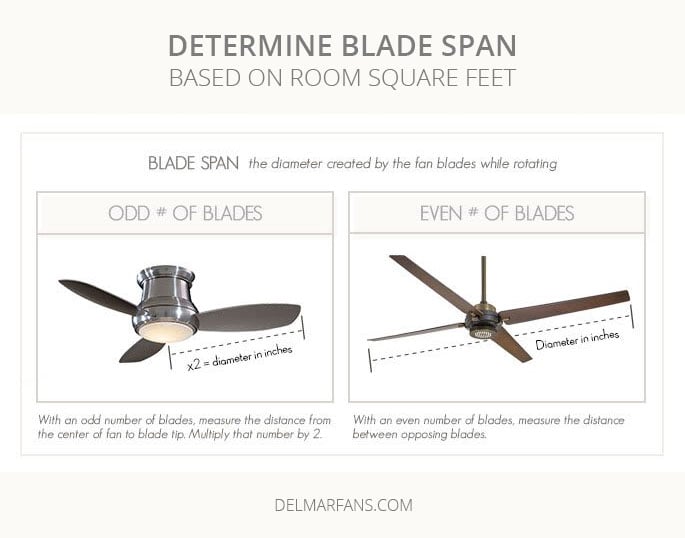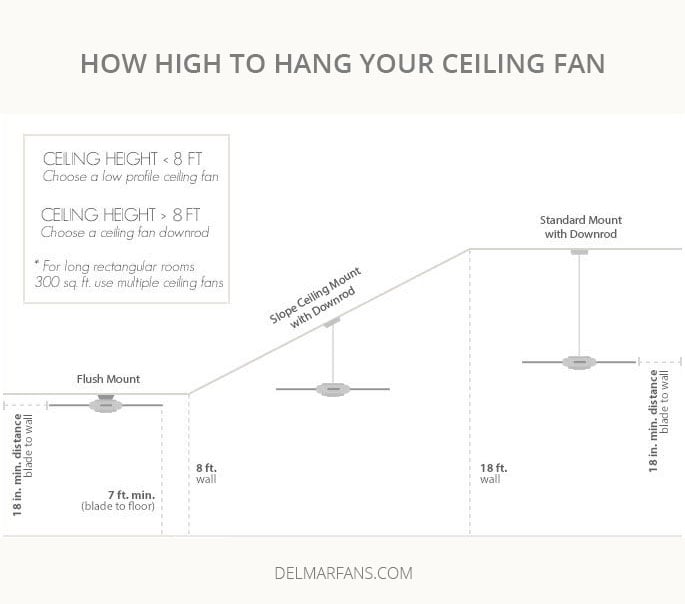Standard Bedroom Size Ceiling Fan
As the saying goes, one should buy small ceiling fans for small rooms and large ceiling fans for large rooms. While this may sound like an ancient proverb, choosing the right size ceiling fan ensures maximum performance, style, and above all – comfort. The right size ceiling fan will do more than just keep you cool; it can also save you money. Ceiling fans only cost pennies to run when compared to air conditioners, allowing you to increase the temperature on your thermostat and save money on your monthly electric bill. However, before you pick out the perfect fan, you need to know how to size a ceiling fan for your room.
Establishing the proper ceiling fan size for your room secures the fan's performance and longevity, as well as the comfort and safety of the room occupants. A small ceiling fan in a large room will have to work twice as hard to cool you off, which will result in the motor burning out quickly. A large ceiling fan in a small room will create an uncomfortable amount of airflow. Unless you like replacing your ceiling fan every few months or feeling as if you're in a tornado, choose a ceiling fan that is proportionate to the room size.

The size of a ceiling fan is determined by the size of the room or the area which you are looking to cool. To determine the square footage of the room or the area, multiply the length of the room in feet by the width of the room in feet. The total you receive from this calculation is the size of your room in square feet. For example, if your room is 8' by 8', the square footage is 64 square feet.
See the Ceiling Fan Sizes table to understand how square footage relates to ceiling fan size. We also have a section below that discusses how to size your ceiling fan to understand whether you have the correct size or need an upgrade.
Ceiling Fans are commonly installed in the following areas – click to learn more:
- Bedroom
- Living Room
- Office
- Bathroom
- Garage
- Outdoor
Why Buy From Del Mar Fans & Lighting?

There are many reasons to buy from Del Mar Fans and Lighting, however, here are just a few reasons we would like to bring attention to!
- Returns for 90 days.
- Free shipping on all orders of $40+.
- A safe shopping experience.
Shop Our Deals!
Ceiling Fan Sizes
There are four common ceiling fan sizes that you will find when browsing for the perfect ceiling fan for your room: small, medium, large, and great. The sizes and associated blade spans are shown below in the table. While the table is a general guide for ceiling fan sizing based on your room's dimensions, other factors for determining the best ceiling fan size for your room include the room type and layout.
Ceiling Fan Size Guide
| Room Size (In Sq. Feet) | Room Type | Recommended Blade Span | Recommended CFM Rating |
|---|---|---|---|
| Under 144 | Bathroom, Breakfast Nooks, Utility Rooms, Small Bedrooms, Porches | Under 42" Fans | 1,000-3,000 |
| 144-225 | Medium Bedrooms, Kitchens, Dining Rooms, Dens, Patios | 44-50" Fans | 1,600-4,500 |
| 225-400 | Master Bedrooms, Family Rooms, TV Rooms, Small Garages, Gazebos | Fans Over 50" | 2,300-6,500 |
| Over 400 | Great Rooms, Large Garages, Basements, and Open Floor Plans | Fans Over 62" | 5,500-13,500 |
Additionally, the amount of air a ceiling fan can move per minute is measured in cubic feet per minute, or CFM. This measurement provides a more accurate representation of the amount of space a fixture can effectively cool. This figure should be compared with the room's overall cubic footage when deciding which fan will work the best for each space.
When searching for a fan within your desired CFM range, the blade span can give you a general idea of a fans CFM range, but you will always want to want to check the CFM of the specific fan you are interested in as motor type and blade shape can account for a more widened range. Product airflow information provides instructions for correctly calculating your room's cubic footage.
If your main focus is to find a fan with a high CFM, we recommend taking a look at our list of The Best High CFM Fans for Residential Use.
Ceiling Fan Size By Room

What Size Ceiling Fan for Bedroom
One of the most important places to have a ceiling fan is in your bedroom. Not only does the right ceiling fan provide a soothing circulation of the air to keep the climate cool, but it also works to create a quiet hum and block out some of the noises that can often be a distraction from sleep. For a list of the top-performing bedroom fans and to learn more about the best-selling characteristics of bedroom fans, make sure to visit our blog, "The Best Ceiling Fans for Bedroom by Size & Fan Feature."
In terms of sizing your ceiling fan for your bedroom, there are two common size options for bedrooms. If you have a regular sized bedroom of 144 to 225 square feet, then a medium ceiling fan with a blade span of 44 to 50 inches will be a great fit. You will want to check your fan to ensure that its CFM rating is anywhere between 1,600 and 4,500. The higher the CFM rating on your fan, the more air you fan will move.
Shop All Bedroom Ceiling Fans!
What Size Ceiling Fan for Living Room
A common place to entertain guests or to simply relax is often the living room or family room. When searching for the perfect ceiling fan for your living room, an emphasis is often placed on the style of the fan to ensure it makes a lasting impression and matches the current décor. While this is certainly a valid focus of the decision, it's easy to focus on only the look of the fan and not account for the size of your fan or the CFM required to cool the room.
Living rooms, great rooms, and family rooms range vastly in size. To find the right size ceiling fan for your living room it is essential that you focus on the square footage of your room and follow the table above. By finding the appropriate blade span and CFM for your living room you will ensure that your room is cooled effectively.
Shop All Living Room Ceiling Fans!
What Size Ceiling Fan for Office
Getting down to business, sometimes it is easy to wonder whether or not you should even install a ceiling fan in your office. Common thoughts include "will it mesh well with my vibe," "will it blow all of the papers off of my desk," and "will a ceiling fan even fit in the office." These thoughts are all normal, but can be answered with this statement; the ideal office ceiling fan will fit in your office while providing a very gentle circulation and bringing a sleek style to tie your office together. It can be hard to find the perfect fan for your workspace but by following the table above, figuring out the size and CFM you need becomes much easier.
Shop All Office Ceiling Fans!
What Size Ceiling Fan for Bathroom
The bathroom is often where you begin your day getting ready and end your day removing make-up, showering, and preparing for bed. The bathroom is a crucial part of daily routines which is why it's important to have a fan which will provide both form and function. Adding a touch of elegance to your powder room while also offering circulation to cool things down after a hot shower is a great choice.
Because bathrooms can vary in size from half-baths to large, spa-styled lavatories, it is essential to measure the square footage of your bathroom and determine the best size in that fashion by using the table above. Other important considerations for your bathroom fan, aside from size, are wet and damp ratings. Depending on the area over which you will be placing your ceiling fan, you will want to ensure an appropriate moisture tolerance of your fan.
Shop All Bathroom Ceiling Fans!
What Size Ceiling Fan for Garage
The perfect space for work benches, storage, and other activities, your garage should offer a cool climate for any time that you may be spending within its walls. Whether you are going to the garage for a little bit of fun or to get some overdue work accomplished, you should be comfortable. Like other rooms which are exposed to moisture, you will want to make sure you look at ceiling fans with UL wet or damp listings. In our "Indoor vs. Outdoor Ceiling Fans Where to Use Guide" it is recommended that ceiling fans being installed in carports and garages carry a UL damp listing.
When sizing your damp-rated ceiling fan for your garage, most standard garages will require a large ceiling fan with a blade span of 50 to 60 inches. For a large garage with square footage over 400, a great-sized fan with a blade span of over 62 inches is recommended. Make sure to check the table above before deciding on your new fans size.
Shop All Garage Ceiling Fans!
What Size Ceiling Fan for Outdoor Living Space
Whether it be an outdoor kitchen, pergola, or patio, outdoor living spaces bring a relaxing way to be outside while staying cool—if you have an outdoor ceiling fan. Outdoor ceiling fans enhance your outdoor experiences so that you enjoy cool air circulation and avoid pesky flies and mosquitoes. To learn about the most popular outdoor ceiling fans and their characteristics, make sure to check out our blog, "Outdoor Whirled: The Best Outdoor Ceiling Fans."
For outdoor living spaces, the necessary fan size will depend on the size and type of outdoor living area in which you are looking to place your fan. As you will see in the table above, porches up to 144 square feet may only require a small ceiling fan while large gazeboes ranging in square footage from 225 to 400 may require a large ceiling fan with a higher CFM rating to do the job.
Shop All Outdoor Ceiling Fans!
How to Measure A Ceiling Fan?

If you are noticing that your existing ceiling fan isn't moving the air in your room to your expectations there is a chance it is due your ceiling fan blades and their size. A ceiling fan's blade span is an important indicator of its CFM and the room size that it should be placed in.
Knowing how to measure your fan will help determine whether your fan is the correct size and CFM for your room. Alternately, if you are happy with the performance and proportional look of your existing ceiling fan and you just want to know the current measurements, it is helpful to know how to measure a ceiling fan.
As you can see in the graphic above, there are two separate ways to measure your fans existing blade span. If your fan has an odd number of blades, you will measure the distance from the center of the fan to the blade tip and then multiply the number by two. On the other hand, if you have an even number of blades, you will measure the distance between opposing blades, or blades that are symmetrically placed in front of one another on opposites sides of the motor housing.
How High Is Your Ceiling?

Hanging your ceiling fan at the appropriate height ensures that friends and family members won't hit their heads on low-hanging ceiling fans. It also guarantees that they'll be able to feel the airflow the fan produces since fans cool people, not rooms. There should be a 7-foot minimum distance between your ceiling fan's blades and the floor.
If you have a ceiling between 8 and 9 feet, you will need low-profile (aka hugger or flush mount) ceiling fan, which measure at least 12 inches from the ceiling to the lowest point of the fixture and are built to be hung on ceilings as low as 8 feet. They should not be hung on ceilings higher than 9 feet as they would then be less efficient in air circulation.
If your ceiling is less than 9 feet, check out our recommended hugger ceiling fans in our "The Best Huggers are Actually Fans" blog post or click below to shop all flush mount ceiling fans.
Shop All Hugger Ceiling Fans!
If you ceiling is over 9 feet, you will need to install a downrod ceiling fan and the length of the downrod will be determined by the height of your ceiling. Downrods, or ceiling fan mounting rods, allow a ceiling fan to be mounted on either a vaulted or flat ceiling and are available up to 72 inches long. Please visit our "What Size Downrod Do I Need? Guide" to determine what length downrod you need based on your ceiling height.
What Length Downrod Do I Need?
If you would like more assistance tracking down the perfect product, you can always reach our ceiling fan experts at 1-800-724-5501, or you can click to chat!
Related Posts
- The Best Huggers are Actually Fans
- The Best Outdoor Ceiling Fans
- What Length Downrod Do You Need?
- Vaulted Ceiling Slope Adapter
- Outdoor Ceiling Fan Buying Guide
- The Best Ceiling Fans for Bedroom by Size & Fan Feature
- Blown Away: The Best High CFM Fans for Residential Use
What sizing information did you find most helpful? Let us know in the comments below!
Standard Bedroom Size Ceiling Fan
Source: https://www.delmarfans.com/educate/basics/what-size-ceiling-fan-do-i-need/

0 Komentar